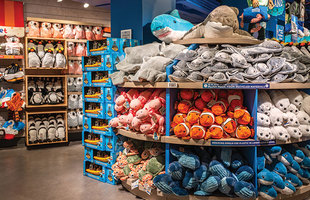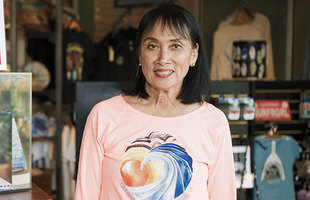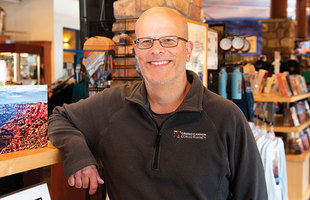The National Building Museum (NBM) in Washington, D.C., aims to inspire curiosity about the world that we design and build. Its vision is to educate, entertain and engage people about the built environment and challenge them to advocate for a sustainable and equitable future.
NBM offers a variety of collections and exhibitions that encompass all facets of design: building design, engineering, graphic design, industrial design and landscape design. It features playful exhibits for guests of all ages as well as permanent collections of photographs, architectural prints, material samples and more for its visitors.
Sticking true to the museum’s vision and mission, museum shop visitors can’t help but be awestruck as they walk into NBM’s store. The 2,800-square-foot shop is spacious and appears even bigger because of its 28-foot-tall ceilings, decked out with playful mobiles. A tall archway invites customers to explore the rooms of the store.

I feel like I have a legacy to continue on. I would hope that whoever comes in here after me will also see that they have a legacy to carry on.” — Michael Higdon
As customers turn to the right, they can browse a wide selection of housewares — cutting boards and tea towels featuring the Washington, D.C., name drop and skyline; a Building Bricks waffle maker; as well as mugs and tumblers. Near that section, customers get lost in the assortment of toys. The shop has no shortage of puzzles, games, building sets and, of course, Legos and other brands of toy bricks. Another section of the store offers a library full of books; the “AIA Guide to the Architecture of Washington, D.C.,” is always a best-selling book for the shop. The store also stocks other traditional souvenirs, such as T-shirts, socks, jewelry and stationery.
Mike Higdon, retail manager at the National Building Museum Shop, says customers often fall in love with the store’s quirky displays and unique product offerings, adding that the store is particularly known for its selection of toys and housewares.
“The one thing about the store that I would say that you hear frequently from the customers is how much fun the store is,” says Higdon. “My predecessor was the driver of that reputation for 25 years. I would not have been able to do what I have done so far with this store had it not been for the foundation that she gave me.”
Higdon, who has served as retail manager for the last 20 years, says he hopes to maintain the store’s legacy of fun during his tenure as manager. “I feel like I have a legacy to continue on,” he says. “I would hope that whoever comes in here after me will also see that they have a legacy to carry on.”
Starting with a shop
Fitting for a museum focused on buildings and design, the NBM building itself has a rich architectural history. It was built in the 1880s to house the headquarters of the U.S. Pension Bureau. At the same time, the building was also used as a space for political functions in Washington and as a building to commemorate the service of those who fought in the Union during the Civil War.
U.S. Army Quartermaster General Montgomery C. Meigs served as the lead architect and engineer for the building. According to NBM’s website, the building “was Meigs’ final and most important architectural work, and the one of which he was most proud.” Roman architecture inspired the building’s interior with open arcade galleries that surround a central hall.
By the 1970s, the structure needed serious repairs. By then, the U.S. Pension Bureau had already moved out of the building; the U.S. government considered demolishing it. Higdon explains that a group of architects got together in the mid-1970s in hopes of saving the building.
“These architects all came together saying, ‘No, no, no — you can’t do this,’” he says. “[The building] was designed as the first fire-proof building in the country. It was also one of the world’s largest brick buildings.”
They also noted that it’s one of the first buildings with a ventilation system to it, and it has what are considered to be some of the world’s largest Corinthian columns, says Higdon.
Congress passed a resolution in 1978 calling for the preservation of the building, and a 1980 Act of Congress mandated the creation of the National Building Museum as “a private, nonprofit educational institution.”
Oddly enough, the museum was a store before it was a museum.
“As I have always understood it, there was an executive director hired to create the museum,” says Higdon. “In working with that process and the founding trustees who were the architects who helped to save the building, they began doing what they needed to do to make the museum a reality. One part of that was raising money. A part of raising that money [involved] selling postcards and other items that promoted the museum’s brand.”

Toys that encourage creativity and products that salute architecture are featured in the museum shop.
While the building underwent repairs and preparations for the museum, Higdon says museum volunteers set up a makeshift storefront in a small vestibule near the front of the building. Bricks imprinted with the shape of the building that could be used as paper weights were top-selling souvenirs for those volunteers.
The museum officially opened its doors in 1985, offering an exhibit on the construction of the Brooklyn Bridge as its first exhibit. In more recent years, the museum shop moved to its much larger, more permanent location adjacent to the museum’s Great Hall and across from the visitor’s center and admission. However, Higdon says, the museum store still has some volunteers who sit in the building’s front vestibule to greet visitors and sell products.
“I’ve got six volunteers currently, and one has been here from those days of selling in the vestibule,” he says, adding that all volunteers have been with the museum store for at least 10 years.
Playful products and experiences
Many of NBM’s exhibits aim to spark visitors’ curiosities and engage them in the building process. Every year, more than 400,000 people stop by the museum, including locals, tourists from across the country as well as some international visitors.
Higdon says the museum has offered a wide variety of exhibits: parking garage exhibits, cement exhibits, fence exhibits and more. The museum features an ongoing exhibit called Play Work Build, which is a hit with families with kids. It invites visitors to see the connections between play, design and the work of building professionals through a hands-on block play area, a wall of virtual blocks and more. Through 2025, guests can also enjoy the museum’s “Brick City” exhibit, which features iconic architecture from around the world that has been recreated using Lego bricks.
Higdon explains that the role of the museum store is to augment visitors’ experience of the built environment.
Customers love the store’s large toy collection. Higdon says an aerodynamic ball called the “Switch Pitch” from John Hansen Company is a top-selling toy for the store. He says, “It’s not a new product. We were carrying it before I came here. It’s a ball you pitch, and as it flies through the air, it opens up and changes colors. Kids love it.”
Higdon adds that the museum store also focuses on stocking products that pertain to history, particularly through its large book section. He notes that he also ensures the store offers products pertaining to famous American architect, Frank Lloyd Wright.
Being in D.C., he says the store also features products with the city’s name drop and unique architecture.

Retail manager Mike Higdon’s hope is that guests get swept up in just how much fun the they can have in the National Building Museum Shop.
“A lot of people come to Washington, D.C., and the only thing they know about is the Washington Monument, the Jefferson Memorial,” he says. “But there’s a lot of other beautiful architecture in this city. It’s probably one of the most European cities in the U.S. We promote that by bringing in unique products about Washington, D.C., that are not based in the usual concept people have of D.C.”
Higdon says he and his team will change the store’s merchandise and displays for different seasons, including D.C.’s cherry blossom season in the beginning of the year, the museum’s summer installation series and the holiday season come mid-fall.
When finding merchandise, Higdon says he likes to find products that get customers thinking, “That’s just fascinating,” or “Wow, I wonder what it would take for me to create something like that.”
Looking to the future, Higdon says he is regularly evaluating and looking at benchmarks related to staffing and merchandising.
He says, “My focus and goal are to regrow our business while developing a team of staff to manage and drive the business.”






